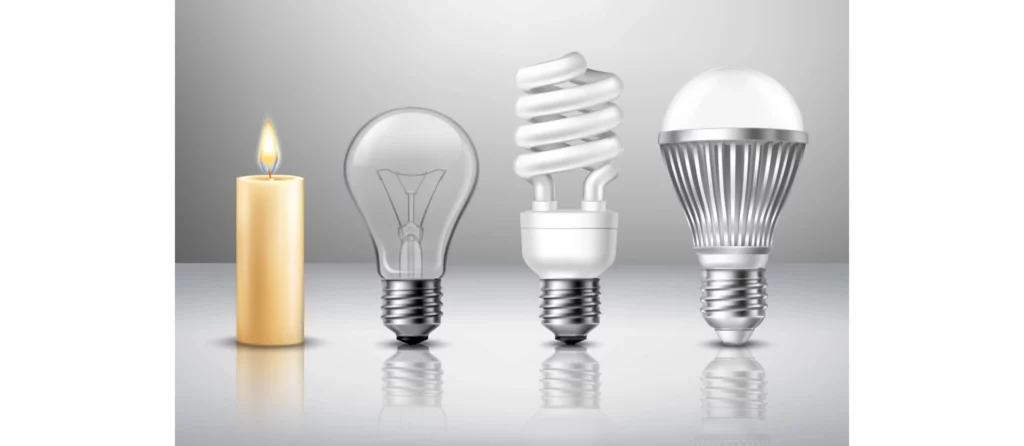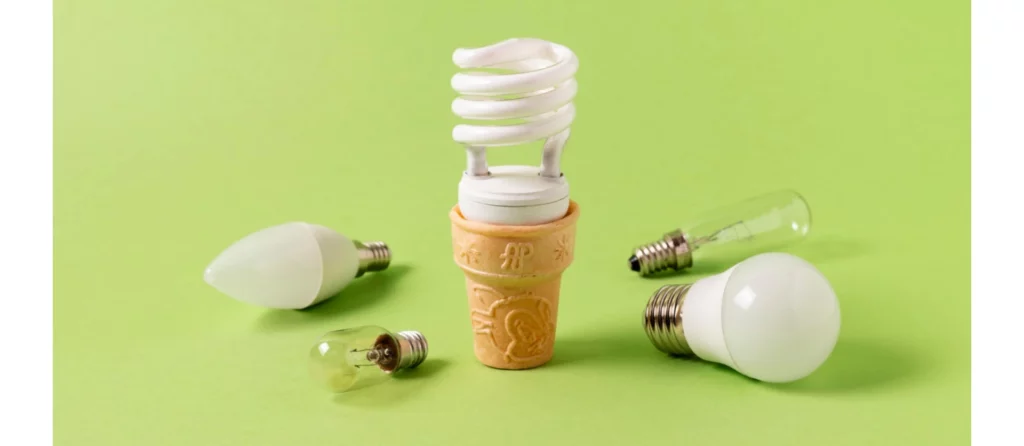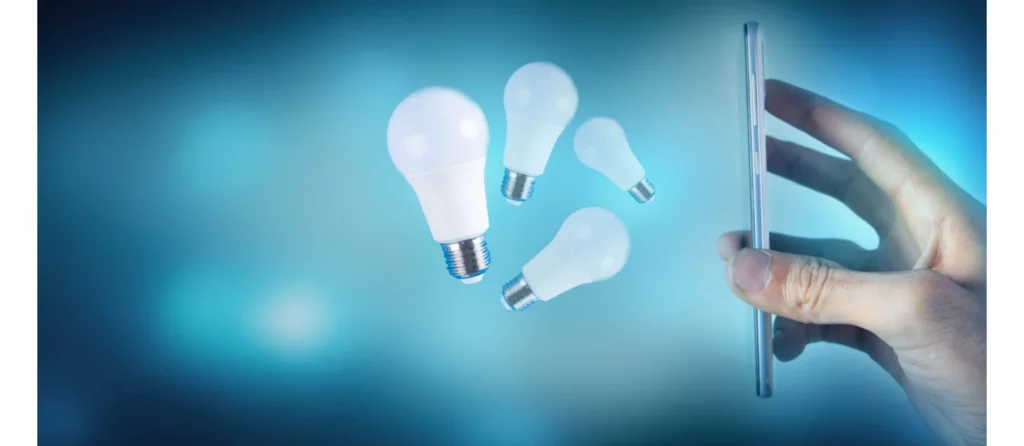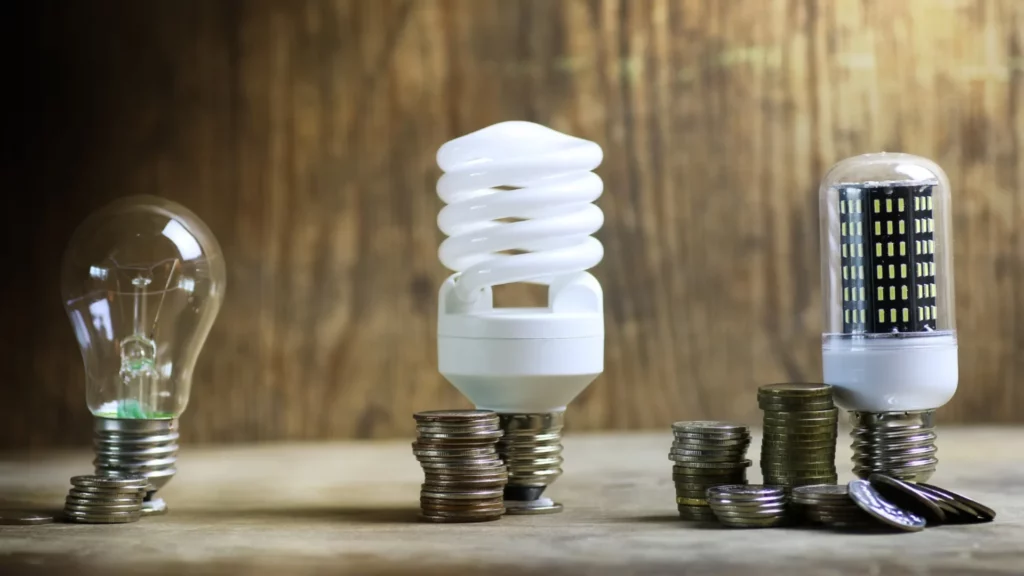You can make your home shine bright for less money and less impact on the environment. An average home spends about 5% of its budget on lighting, which is a lot when you think about it long term.
Energy-efficient lighting bulbs can actually cut your energy bills and this is the fastest way to save up some money. By replacing your most-used light bulbs, you can save up to $45 every year.
There are many different bulbs like CFL, LED, and halogen incandescent available with the energy star of efficacy.
So, your best bet is to go with light bulbs that have that energy star.
What are Energy Efficient Light Bulbs?
Energy-efficient light bulbs are better than traditional incandescent bulbs because they use less energy and have a longer lifespan. Incandescent bulbs are inefficient and waste energy as heat. This makes them less energy-efficient and more expensive to use.
Energy-efficient light bulbs like LEDs and CFLs use less energy than incandescent bulbs while providing the same amount of light. This saves consumers money and reduces greenhouse gas emissions.
Energy-efficient bulbs have a longer lifespan than traditional incandescent bulbs. Incandescent bulbs last around 1,000 hours, while LEDs can last over 25,000 hours and CFLs can last 8,000 to 10,000 hours.
This reduces the need for replacements, saving costs and benefiting the environment.
The shift towards energy-efficient lighting is part of a broader movement towards sustainability and conservation, aiming to reduce energy consumption and its associated impacts on the planet.

What’s the Difference Between The Old and The New?
The shift from traditional to modern lighting technologies represents a significant advancement in energy efficiency and customization.
Traditional incandescent bulbs, prevalent in the past, were highly inefficient, converting only about 10% of their energy into light with the rest lost as heat. This inefficiency led to increased energy consumption and higher utility costs.
Modern lighting solutions, such as LEDs (Light Emitting Diodes) and CFLs (Compact Fluorescent Lamps), stand in stark contrast.
They consume far less energy for the same amount of light, significantly reducing both energy consumption and utility bills. LEDs, in particular, are renowned for their efficiency, longevity, and minimal heat emission.
Furthermore, modern lighting offers a broader range of options in terms of color and brightness, allowing users to tailor their lighting according to different needs and preferences.
This versatility enhances both the functionality and ambiance of spaces, marking a considerable improvement over the limited choices provided by traditional bulbs.
Overall, the transition to modern lighting not only aligns with environmental and economic goals but also brings enhanced customization to lighting design.

So, What Choices Do You Have?
Halogen incandescent, compact fluorescent lamps (CFLs), and light-emitting diodes (LEDs) are popular energy-efficient lighting options.
Though more expensive initially, they offer long-term savings due to lower energy use and longer lifespans compared to traditional bulbs.
Available in hardware and home improvement stores, these bulbs work well with various controls like photocells and timers to minimize electricity usage. It's essential to ensure that dimmers are compatible with these energy-efficient bulbs.
For outdoor lighting, especially if left on for extended periods, CFLs and LEDs are recommended for their efficiency. Most spiral CFLs can be used in enclosed fixtures, providing weather protection.
Both CFLs and LEDs are also available as floodlights, capable of enduring outdoor conditions without additional enclosures.
Energy Star-rated fixtures are ideal for outdoor use, often featuring automatic daylight shutoff and motion sensors for enhanced energy savings.

Choosing the Right Energy Efficient Light Bulb for Your Needs
Choosing the right energy-efficient light bulb can be overwhelming. To make an informed decision, consider these key factors: brightness, color temperature, lifespan, and wattage.
- Brightness and Lumens: In the past, bulb selection was based on wattage, but energy-efficient bulbs use lumens instead. Lumens indicate brightness, with a 60-watt bulb emitting around 800 lumens. Choosing a bulb based on lumens ensures it meets your desired brightness.
- Color Temperature: The color temperature of a light source determines its character – warm or cool. Warmer temperatures resemble incandescent bulbs, while cooler temperatures give a bluish-white light. Choosing the temperature allows you to create the desired atmosphere.
- Wattage Equivalence: Energy-efficient light bulbs use a wattage equivalence metric to help users switch from traditional bulbs. For example, a 10-watt LED bulb may be seen as equal to a 60-watt incandescent bulb. This measure helps gauge energy consumption and performance, making it easier to switch to more efficient options.
- Dimmer Switch Compatibility: To use dimmer switches, check if the energy-efficient bulb is “dimmable.” This ensures you can adjust light intensity and mood based on your preferences.

Halogen Incandescents
Halogen incandescent bulbs are an enhanced form of traditional incandescent lighting, featuring a halogen gas-filled capsule around the filament.
This design boosts their efficiency and lifespan compared to standard incandescent bulbs. They comply with federal minimum energy efficiency standards, making them a more eco-friendly choice.
These bulbs are known for their instant illumination and superior color rendering, making them ideal for environments where color accuracy is important.
They come in various shapes and sizes and offer features like dimming capabilities and different color options, providing versatility for different lighting needs.
While not as energy-efficient as some modern lighting technologies like LEDs, halogen incandescents are favored for their warm, natural light. They fit well in both residential and commercial settings due to their quality lighting and compatibility with existing fixtures.
In summary, halogen incandescent bulbs offer a balance of improved efficiency, quality light, and versatility, making them a viable option for those seeking a better alternative to traditional incandescent bulbs.

CFLs
Compact Fluorescent Lamps (CFLs) are a more compact and energy-efficient alternative to traditional long-tube fluorescent lights, commonly used in residential and commercial settings.
These lamps use about one-fourth of the energy of standard incandescent bulbs and can last up to ten times longer, offering significant energy savings and reduced replacement frequency. Despite their higher initial cost, CFLs can become cost-effective within nine months due to these savings.
Initially, CFLs were criticized for emitting a colder light, but advancements have led to a variety of color options, including warmer tones that are more appealing for home use.
Modern CFLs are available in different shapes, some of which are designed to more effectively distribute light. Dimmable CFLs are also an option for adjustable lighting needs.
It's important to handle CFLs responsibly as they contain a small amount of mercury. Many recycling programs and facilities accept CFLs for free, ensuring safe disposal and mitigating environmental impact.

LEDs
Light Emitting Diodes (LEDs) have evolved from simple indicator lights to a dominant lighting technology due to their energy efficiency and longevity.
Consuming only about 20%-25% of the energy used by traditional bulbs and lasting 15-25 times longer, LEDs have earned an ENERGY STAR rating for their efficiency.
These versatile lights are available for various applications, including standard and reflector bulbs, track lights, desk lamps, kitchen under-cabinet lighting, and outdoor area lighting.
LEDs offer a wide range of colors, dimmable options, and can incorporate motion or daylight sensors. They are especially durable, making them suitable for both indoor and outdoor use, with popular outdoor options like pathway and solar-powered lights.
Though initially more expensive, LEDs are cost-effective in the long run due to their energy savings and long lifespan, significantly reducing energy bills and replacement costs.

6 Benefits Of Energy-Efficient Light Bulbs
The benefits of energy efficient light bulbs may be quite obvious but you should still be reminded of what they are before you make any big decisions.
For one, they require much less energy to work properly. Here’s a look at what other benefits energy efficient light bulbs can bring us.
- Efficiency: CFLs are 4x stronger and last 10x longer than regular bulbs. LED bulbs last 24/7 for 11 years and significantly reduce energy costs. This saves money on bulb replacements and lowers electricity bills.
- Lower emissions: By replacing one bulb with an energy efficient one, emissions can be cut by half a ton. If each US citizen replaces just one bulb, emissions reduced would match those from 800,000 cars. Imagine the significant difference you can make.
- Electricity savings: Energy efficient bulbs cost more at the outset than the traditional incandescent bulbs, these will offer valuable savings later on, over their lifetime by lasting longer and using less energy.
- Versatility: The energy efficient bulbs can now replace almost any incandescent bulb, which is amazing and really useful in many homes. There are CFLs that can work on dimmer switches and on three way lamps and so on.
- Durability: LEDs are durable, as they can withstand bumps and weather. Unlike regular bulbs, they lack a filament and break less frequently. Opting for these energy-saving bulbs is a wise choice, saving you money despite potential higher initial costs.
- Meta Description: So, you've probably heard a lot about energy efficient light bulbs. However, you are still not sure which ones to get. Here's an article that can help you solve that problem and learn more about energy efficient light bulbs.
Conclusion
As I explore energy-efficient light bulbs, a captivating transformation emerges. Traditional incandescent bulbs contrast sharply with modern ones, showcasing a shift from wastefulness to sustainability.
The familiar incandescent bulbs, although providing light, are now exposed for their inefficiency, wasting energy as heat and depleting both finances and resources.
Energy-efficient bulbs offer a hopeful future, resonating as a cost-effective choice and a commitment to a greener world.
Each saved watt is a small step towards lightening the burden on our environment, inspiring me to contribute.
Source:

